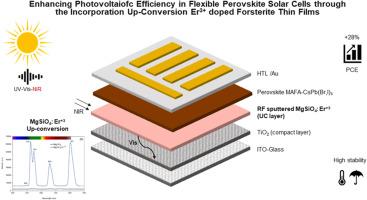Enhancing photovoltaic efficiency in flexible perovskite solar cells through the incorporation of up-conversion Er3+ doped forsterite thin films
IF 6.3
2区 材料科学
Q2 ENERGY & FUELS
引用次数: 0
Abstract
Perovskite solar cells (PSCs) have garnered attention due to their high efficiency and cost-effective production. However, their limited absorption in the near-infrared (NIR) range constrains their potential, as NIR accounts for 44 % of the solar spectrum. To address this, we incorporated an erbium-doped forsterite (Mg₂SiO₄:Er³⁺) up-conversion layer into flexible PSC (MAFA-CsPb(Br,I)₃), converting NIR photons into visible light to enhance power conversion efficiency (PCE). This integration resulted in a significant increase in PCE from 16.1 % to 20.6 %, with the device also showing improved open-circuit voltage (Voc) from 1.05 V to 1.19 V and a higher short-circuit current density (Jsc) from 22.1 to 23.1 mA/cm2. Additionally, the thermal and moisture stability of the cells was enhanced, retaining 75 % of their initial efficiency after 500 h under ambient conditions. The use of erbium-doped forsterite as an up-conversion layer presents a promising strategy for overcoming spectral limitations and improving the durability of PSCs, providing a pathway toward more efficient and stable next-generation photovoltaic devices.

通过在柔性过氧化物太阳能电池中加入上转换型掺杂 Er3+ 的紫柱石薄膜提高光电效率
过氧化物太阳能电池(PSCs)因其高效率和低成本生产而备受关注。然而,由于近红外(NIR)光谱占太阳光谱的 44%,因此其在近红外(NIR)范围内的有限吸收限制了其潜力。为了解决这个问题,我们在柔性 PSC(MAFA-CsPb(Br,I)₃)中加入了掺铒的紫硼酸盐(Mg₂SiO₄:Er³⁺)上转换层,将近红外光子转换成可见光,以提高功率转换效率(PCE)。这种集成使 PCE 从 16.1% 显著提高到 20.6%,器件的开路电压 (Voc) 也从 1.05 V 提高到 1.19 V,短路电流密度 (Jsc) 从 22.1 mA/cm2 提高到 23.1 mA/cm2。此外,电池的热稳定性和湿度稳定性也得到了提高,在环境条件下使用 500 小时后,其初始效率仍能保持 75%。使用掺铒紫硼酸盐作为上转换层是克服光谱限制和提高聚光太阳能电池耐久性的一种有前途的策略,为实现更高效、更稳定的下一代光伏设备提供了一条途径。
本文章由计算机程序翻译,如有差异,请以英文原文为准。
求助全文
约1分钟内获得全文
求助全文
来源期刊

Solar Energy Materials and Solar Cells
工程技术-材料科学:综合
CiteScore
12.60
自引率
11.60%
发文量
513
审稿时长
47 days
期刊介绍:
Solar Energy Materials & Solar Cells is intended as a vehicle for the dissemination of research results on materials science and technology related to photovoltaic, photothermal and photoelectrochemical solar energy conversion. Materials science is taken in the broadest possible sense and encompasses physics, chemistry, optics, materials fabrication and analysis for all types of materials.
 求助内容:
求助内容: 应助结果提醒方式:
应助结果提醒方式:


